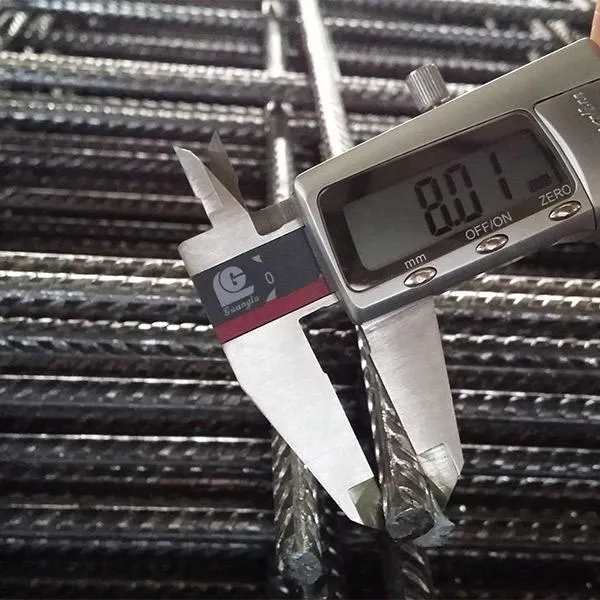Jun . 26, 2025 09:10 Back to list
Ssential Reinforcing Mesh For Modern Construction Projects
The construction industry continuously evolves with new materials and technologies designed to enhance structural integrity and efficiency, with reinforcing mesh standing out as a critical component in modern building projects. This welded steel grid system provides unparalleled support to concrete structures, ensuring they withstand environmental stressors and the test of time. As a premier wholesaler of construction materials, we supply high-grade Q235 concrete reinforcing mesh manufactured to meet exacting standards for commercial, industrial, and infrastructure developments, as reinforcing mesh for concrete building has become indispensable for preventing cracks, improving load distribution, and accelerating construction timelines. This guide explores the properties, applications, and selection criteria for reinforcing mesh, offering valuable insights for contractors, engineers, and project managers.

Understanding Reinforcing Mesh and Its Structural Benefits
Reinforcing mesh, technically known as welded wire mesh, represents a significant advancement in concrete reinforcement technology. This engineered material consists of high-tensile steel wires precision-welded at their intersections to form a rigid grid structure that becomes integral to the concrete matrix when embedded. The fundamental advantage over conventional rebar systems lies in its prefabricated panel configuration, which eliminates the labor-intensive process of manual rebar tying while ensuring consistent wire spacing and alignment accuracy.The structural benefits of this system are manifold: 1) Superior crack control achieved through optimal stress distribution that compensates for concrete's inherent tensile weakness, effectively resisting forces from drying shrinkage, thermal cycling, and dynamic loading conditions; 2) Enhanced load capacity that makes Q235-grade reinforcing mesh particularly suitable for demanding applications like industrial flooring systems, bridge decks, and heavy traffic zones where structural integrity is paramount; 3) Significant construction efficiency gains through the elimination of field fabrication work, reducing both labor hours and skilled labor requirements while enabling faster project completion; 4) Economic advantages stemming from minimized material waste and reduced installation complexity compared to traditional reinforcement methods; 5) Extended service life through superior corrosion resistance and structural stability that dramatically reduces maintenance interventions; and 6) Unparalleled adaptability that allows seamless integration into projects ranging from residential concrete slabs to large-scale civil engineering works like highway systems and tunnel constructions.
Comprehensive Applications of Reinforcing Mesh in Construction
Reinforcing mesh demonstrates exceptional versatility across diverse building applications, with key uses including: 1) Concrete flooring systems - In industrial and commercial flooring (warehouses, factories, retail spaces), it prevents surface cracking and ensures even weight distribution under heavy machinery and vehicle loads; for residential slabs, Q235 concrete reinforcing mesh combats settlement cracks and ground movement. 2) Road and pavement construction - Critical for highways, airport runways, and city streets, it reduces reflective cracking, enhances load distribution, and can extend pavement lifespan by 30%. 3) Foundation and retaining walls - Reinforcing mesh for concrete building fortifies foundations against soil pressure, hydrostatic pressure, and seismic activity, while in retaining walls it prevents bulging or collapse. 4) Precast concrete manufacturing - Essential for producing uniform-strength concrete panels, beams, columns, staircases, and tunnel segments. 5) Infrastructure projects - Bridge decks utilize it to withstand dynamic traffic loads and de-icing salts, while tunnels and underground structures rely on it to resist earth pressure, prevent water infiltration, and maintain structural stability.
Selecting the Optimal Reinforcing Mesh for Your Project
Selecting the appropriate reinforcing mesh involves careful analysis of multiple engineering specifications to guarantee optimal structural performance and long-term durability. The primary selection parameters consist of: 1) Material composition - Standard Q235 concrete reinforcing mesh provides excellent weld strength and formability characteristics for conventional construction projects, making it essential for earthquake-resistant buildings, heavy industrial flooring systems, and critical infrastructure elements requiring enhanced load capacity. 2) Corrosion prevention methods - The selection of protective coatings must correspond to the project environment: Uncoated black steel offers economical solutions for dry interior applications with 20-30 years of service life; Hot-dip galvanized mesh creates a zinc barrier that ensures 50+ years of protection in marine environments and humid climates; Epoxy-coated reinforcement provides exceptional chemical resistance for industrial plants, waste management facilities, and transportation structures exposed to corrosive agents. Additional technical considerations include wire spacing configurations, diameter tolerances, and installation compatibility to meet specific structural engineering requirements and construction practice standards.
Reinforcing Mesh FAQs
How does Q235 concret reinforcing mesh compare to rebar in terms of strength?
While individual rebar may have higher tensile strength, Q235 concrete reinforcing mesh provides more uniform reinforcement across surfaces. For most slab applications, mesh offers comparable performance with easier installation.
What's the minimum concrete cover required over reinforcing mesh?
Industry standards typically require minimum concrete cover thicknesses of 20mm for indoor structures, 40mm for exterior/exposed elements, and 50mm for marine environments.
Can reinforcing mesh be used in seismic zones?
Yes, when properly specified. In high-seismic areas, engineers often combine reinforcing mesh with additional rebar to create a dual-reinforcement system.
How does temperature affect reinforcing mesh performance?
Reinforcing mesh maintains its properties between -40°C to 100°C. In extreme climates, thermal expansion joints should be incorporated into the design.
What quality certifications should I look for in reinforcing mesh?
Reputable suppliers should provide:1)ISO 9001 certification 2)Mill test certificates 3)Compliance with ASTM A185 or BS 4483 standards
-
Storage Solutions for Cheap Twisted Square Bar
NewsAug.11,2025
-
Installation Guide for Pod Slab Reinforcing Mesh
NewsAug.11,2025
-
How to Choose the Right Galvanized Wire Mesh Rolls
NewsAug.11,2025
-
Fence Barbed Wire Security Features
NewsAug.11,2025
-
BRC Welded Wire Mesh Installation Tips
NewsAug.11,2025
-
Advantages of Serrated Stainless Steel Grating
NewsAug.11,2025

